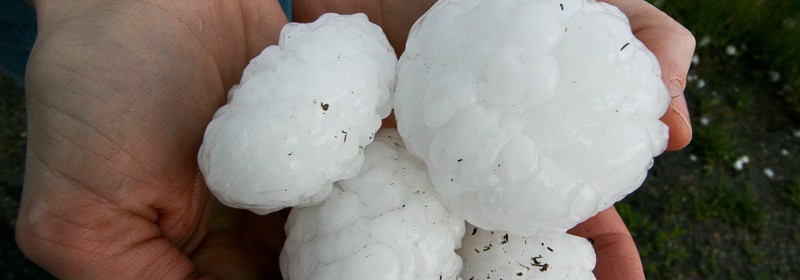Hailstone – Lack of hail causes concern

What is hail or a hailstone?
- Hail is a form of precipitation that occurs when updrafts in thunderstorms carry raindrops upward into extremely cold areas of the atmosphere where they freeze into balls of ice. Hail can damage aircraft, homes and cars, and can be deadly to livestock and people.
- How does hail form?
- Hailstones grow by colliding with supercooled water drops. Supercooled water will freeze on contact with ice crystals, frozen raindrops, dust or some other nuclei. Thunderstorms that have a strong updraft keep lifting the hailstones up to the top of the cloud where they encounter more supercooled water and continue to grow. The hail falls when the thunderstorm’s updraft can no longer support the weight of the ice or the updraft weakens. The stronger the updraft the larger the hailstone can grow.
Hailstones can have layers like an onion if they travel up and down in an updraft, or they can have few or no layers if they are “balanced” in an updraft. One can tell how many times a hailstone traveled to the top of the storm by counting the layers. Hailstones can begin to melt and then re-freeze together – forming large and very irregularly shaped hail.
- How does hail fall to the ground?
- Hail falls when it becomes heavy enough to overcome the strength of the updraft and is pulled by gravity towards the earth. How it falls is dependent on what is going on inside the thunderstorm. Hailstones bump into other raindrops and other hailstones inside the thunderstorm, and this bumping slows down their fall. Drag and friction also slow their fall, so it is a complicated question! If the winds are strong enough, they can even blow hail so that it falls at an angle. This would explain why the screens on one side of a house can be shredded by hail and the rest are unharmed!
- How fast does hail fall?
- We really only have estimates about the speed hail falls. One estimate is that a 1cm hailstone falls at 9 m/s, and an 8cm stone, weighing .7kg falls at 48 m/s (171 km/h). However, the hailstone is not likely to reach terminal velocity due to friction, collisions with other hailstones or raindrops, wind, the viscosity of the wind, and melting. Also, the formula to calculate terminal velocity is based on the assumption that you are dealing with a perfect sphere. Hail is generally not a perfect sphere!
- What areas have the most hail?
- Though Florida has the most thunderstorms, Nebraska, Colorado, and Wyoming usually have the most hail storms. The area where these three states meet – “hail alley,” averages seven to nine hail days per year. The reason why this area gets so much hail is that the freezing levels (the area of the atmosphere at 32 degrees or less) in the high plains are much closer to the ground than they are at sea level, where hail has plenty of time to melt before reaching the ground. Other parts of the world that have damaging hailstorms include China, Russia, India and northern Italy.
When viewed from the air, it is evident that hail falls in paths known as swaths. They can range in size from a few acres to an area 10 miles wide and 100 miles long. Piles of hail in hail swaths have been so deep, a snow plow was required to remove them, and occasionally, hail drifts have been reported.
- How large can hail get?
- Hail is usually pea-sized to marble-sized, but big thunderstorms can produce big hail. The largest hailstone recovered in the U.S. fell in Vivian, SD on June 23, 2010 with a diameter of 8 inches and a circumference of 18.62 inches. It weighed 1 lb 15 oz.
- Estimating Hail Size
- Hail size is estimated by comparing it to a known object. Most hail storms are made up of a mix of sizes, and only the very largest stones pose serious risk to people caught in the open.
- Pea = 1/4 inch diameter
- Marble/mothball = 1/2 inch diameter
- Dime/Penny = 3/4 inch diameter
- Nickel = 7/8 inch
- Quarter = 1 inch — quarter size or larger is considered severe
- Ping-Pong Ball = 1 1/2 inch
- Golf Ball = 1 3/4 inches
- Tennis Ball = 2 1/2 inches
- Baseball = 2 3/4 inches
- Tea cup = 3 inches
- Grapefruit = 4 inches
- Softball = 4 1/2 inches

 Print
Print